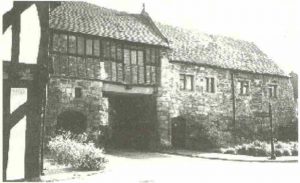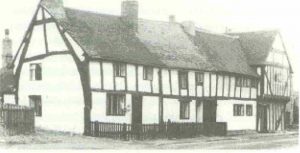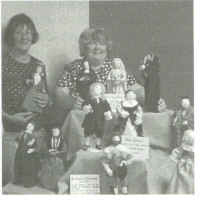Recent archaeological research indicates that Polesworth, situated in the Anker valley in North Warwickshire, has been regarded as a good place to live ever since it was selected as a camp site by early nomadic clans. An ideal defensive site, protected on three sides by the river and hidden within the folds of the surrounding countryside, even today when only remnants of the ancient Forest of Arden remain – photographers have difficulty finding a view of the Abbey and village centre from nearby hilltops. It is, therefore, no surprise to find examples of most building styles and materials within the parish boundaries. During the Saxon and Norman eras, the town centred around the powerful, richly endowed, Benedictine Abbey – its Norman arcade, imposing Nunnery Gateway, recently renovated cloister wall, picturesque _bbess’ doorway and the stone effigy of Abbess Osanna remain as our legacy. The original settlement pattern can still be recognised, with houses to one side of both Bridge Street and High Street, clustered along the Abbey’s boundary walls, whilst those opposite stood in approximately one acre plots. Traditional cruck style houses remain, although only one has retained its thatch roof. (see photo above right) Renowned for the quality of education provided for the daughters of wealthy patrons, Polesworth Abbey amassed lucrative land holdings and controlled a number of mills around the country. Its nuns were granted a charter market and fair and in later years Polesworth Fair was reputed to be one of the largest hiring fairs in the country, with people ‘travelling up to thirty miles to attend’! Traditionally held on the ‘Hall Court’ – adjacent to the Tithe Barn and Dovecote – ensured that area remained an open space until the 1950’s when it was chosen as the best site for the Memorial Hall and Library. A large section, however, remains as open space, maintained by the Community Association.

Both the Abbey and the Cockayne family who later rebuilt nearby Pooley Hall in 1508 as one of the earliest examples of a ‘brick built castellated mansion’, were granted the right to ‘impail’ hunting parks. It is believed that the boundaries of Abbey Green Park, opposite the Abbey (which was gifted to the village when the opencast workings were completed in the early 1960’s), probably follow at least some of the ancient boundaries of the original hunting park. Residents and visitors are therefore able to enjoy similar views to those extolled by the many literary figures who either lived in the vicinity or were frequent guests of the Goodere family, who had purchased the ‘estate ‘in 1544, following the voluntary dissolution of the Abbey in 1539. Michael Drayton (Poet Laureate) having been a page in the Goodere household, based a number of his poems upon his childhood surroundings – Lady Anne Goodere being the lady portrayed as his ‘Idea’ in many of his works. Ben Jonson, Hugh Holland, Inigo Jones were particular friends of the family, as was John Donne, who not only co-wrote a number of literary works with Sir Henry Goodere but exchanged letters ‘of the most intimate kind’ – often on a daily basis. As to whether or not the young Will Shakespeare lived and was educated at Polesworth…………….documentary evidence of his early years is proving elusive but many scholars believe Polesworth’s claim has some validity. A claim we suspect which will continue to excite literary debate. The area can certainly claim that Raphael Hollinshed, whose famous ‘history’ is acknowledged as the primary source for Shakespeare’s historical works, was employed by the Burdett family as steward of nearby Bramcote Hall, where he died in 1580. Banished to Polesworth by Charles 1, Lady Lucy Goodere and her husband Sir Francis Nethersole continued the nuns’ educational legacy and formally founded schools for both girls and boys in 1638. Rebuilt by their Trustees in 1818, the imposing cupola topped school building dominates the main shopping area of the village, and is now a busy centre for community activities.
The Coventry Canal opened in 1790 – the village expanded across the river as boat yards, wharves, blacksmiths, farriers and shops opened to service the ‘canal folk’ for whom Polesworth became a regular overnight stop. A river bridge of stone replaced earlier wooden constructions, although until the mid1900’s carts etc still sometimes used the ‘pool’ – the traditional Saxon crossing. The construction of two large viaducts (early work of Bassett who went on to construct railroads across Europe and America) was completed in 1848. Henceforth, Polesworth could only be accessed via a bridge. Sand, gravel, clay and coal, plus finished goods, could all reach a larger market. Bell pits abound, much to the dismay of present day builders, and Polesworth pottery has been identified on archaeological sites around the Midlands. Today, the only remaining example of the many traditional yards ‘is a small section of Foster’s Yard’ near the Fire Station. Around the end of the nineteenth century new sources of power enabled pit owners to reach deep coal seams, and the sale in 1912 of the Polesworth estate in individual lots allowed construction of new homes to house a growing population. Electricity was available from 1924 and Polesworth residents were able to source almost all their needs ‘in house’. Water mill, cinema, farms, shops, churches, chapels, clubs, pubs and houses intermingled as the village expanded.


During the war years Polesworth welcomed evacuees – the ‘Bevan boys’, a land army hostel, prisoner of war camp and ‘the fair folk’ who were prevented from travelling by wartime restrictions. The 1960’s witnessed the closure of the boatyard, clay works and ‘village’ mine at Pooley. Although all the miners were redeployed nearby, for the first time a majority of residents were forced to travel to work. Polesworth’s amenities and position made it a prime development location. Fortunately a number of factors combined to ensure that the residents of most edge-of-village developments had time to be assimilated into community life before another site was developed and to date, the open green spaces around the river and Abbey remain. Hopefully this generation will be able to both retain and maintain them for future residents and visitors to enjoy. As to the future, the recently opened Heritage Centre at Pooley Fields was designed to meet the latest sustainable and energy efficient construction methods available. Funding is in place to begin work on renovating the Grade 2 listed Congregational Church and its opening as a centre to display the Polesworth Society’s extensive collection of photographs, artefacts and collection of costume figures lovingly stitched (and stuck!) by Society members under the kind and watchful eye of Margaret Prior, now our Secretary. Little did she realise when she ‘volunteered’ just how many historical figures there were in Polesworth, but it is hoped that Princess Editha, the Bendictine Nuns, Leticia D’Arden, Henry 1st’s Saxon concubine from Pooley Hall, the Gooderes, Cockaynes, Chetwynds, miners, millers, canal folk, morris dancers et al can be joined by Claud Grahame-White (who landed in Polesworth in 1910); the Chaytor family (who produced electricity for Polesworth and were amongst the first to open pit head baths); and Alan Lloyd who opened the first of his chain of chemist shops in the village, etc

Work continues on the Parish Council/Polesworth Society web site, planning applications still need comments, and the hopefully much revised North Warwickshire Plan should be published soon. The sympathetic restoration of the neglected cottage and outbuildings on the Bridge Street/High Street corner which presented a depressing sight when ASHTAV members walked around the village in October 2002, is nearing completion, set to provide four much needed smaller dwellings. Polesworth’s inclusion within the Countryside Agency’s “Market Towns Initiative” is providing an excellent opportunity, not only for the community to work together to meet its changing needs, but to once again realise some of Polesworth’s undoubted assets to ensure it remains a welcoming community where people are happy to live and work.
We should like to thank Sue Collins of the Po/esworth Society for preparing this history of their town and for supplying the photographs taken by Members of their Society.
